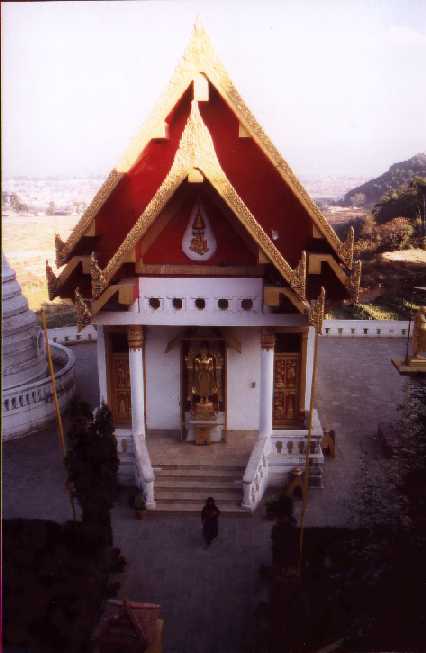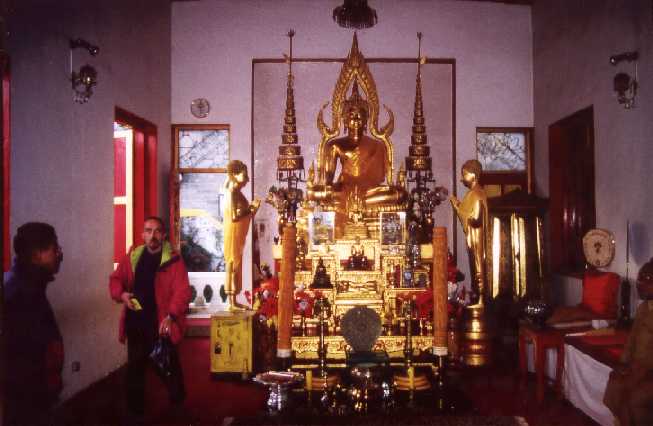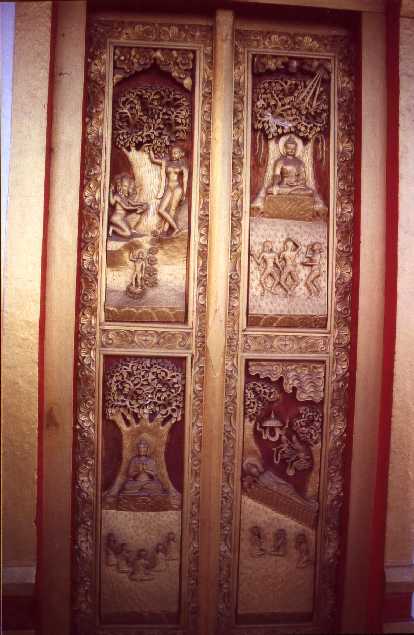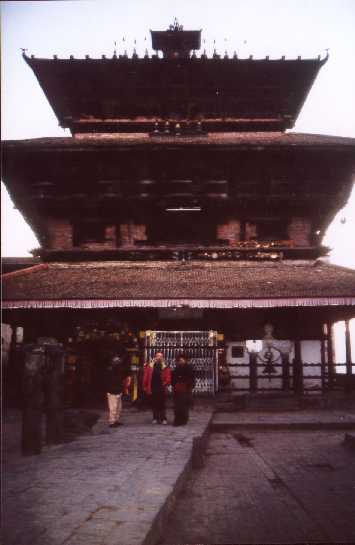The Picture Gallery (contd...)
Getting around Kathmandu
The rest of our already counted days in Nepal we spent getting around Kathmandu and the closer valley. Two good friends, Rakesh and Bigya, showed us some of the most beautiful sights and sites around there. For this we visited Kirtipur, made a day-hiking-trip to one of the summits nearby, made another attempt to watch the unique sunrise in Nagarkot and last but not least we attended the stunning night life of downtown Kathmandu.
Kirtipur
Getting around Kathmandu, there are also lots of historic sites to discover. Who wants to visit a typical Newar village should consider going to Kirtipur, also as an alternative to the tourist crowded cities of Patan and Bhaktapur. So we did. The once-proud KIRTIPUR ("City of Glory") occupies a long, low battleship of a ridge 9 km south west of Kathmandu. An historic stronghold commanding a panoramic view of the valley, the town is ideal for wandering, yet seldom visited - outsiders tend to get stared at. Poor Kirtipur is still shunned and pitied in the Kathmandu Valley, more than two centuries after its spirit was broken by an act of spectacular cruelty and humiliation.
Kirtipur was founded between 1099 and 1126 by King Shiva Deva and in the fifteenth century, during the time of the Malla kings, it became a flourishing settlement. When in 1482 the Kathmandu Valley got subdivided into three different empires (Kantipur (Kathmandu), Lalitpur (Patan) and Bhaktapur), it got established as a western outpost of Patan. Nevertheless, Kirtipur had gained nominal independence until Prithvi Narayan Shah began his final conquest of the Kathmandu Valley in 1767. The Gorkha King, who had himself been born and raised in a hilltop fortress, considered Kirtipur a strategic linchpin of the valley and made its capture his first priority. After two separate attacks and a six month siege, with no help forthcoming from Patan, Kirtipur surrendered on the understanding it would receive a total amnesty - instead, in an atrocity intended to demoralize the remaining opposition in the valley, Prithvi Narayan Shah ordered his troops to cut off the noses and lips of every man and boy in Kirtipur. "This order was carried out in the most exact way," wrote the early twentieth-century traveler Percival Landon, "and it adds rather than detracts from the savagery of the conqueror that the only persons spared were men who were skilled in playing wind instruments. The grim statistic is added that the weight of the noses and lips that were brought to Prithvi Narayan in proof that his order had been obeyed amounted to no less than eighty pounds." The rest of the valley fell within a year.
Kirtipur's hilltop position, once a strategic asset, has become a serious handicap to development, for although a road was belatedly pushed up to the neglected upper town, almost all of Kirtipur's commerce has shifted to Naya Bazaar (New Market) at the southern base of the hill. The majority of the people living in Kiritpur traditionally are traders from the so-called Shreshta sub-caste or Jyapus (members of the Newar farming sub-caste). The Jyapus work the fields below the town and in spring and fall haul their sheaves up and thresh the grain in the narrow streets. Others, whose land was appropriated for the building of Tribhuwan University (Nepal's largest, with 5000 students), now commute to jobs in Kathmandu or produce handicrafts behind closed doors. The village's unpaved, narrow lanes and mainly low-income inhabitants seem out of place so close to the prosperous capital, and in recent years it has been singled out by some tour companies as an example of picturesque poverty. Fortunately, prosperity is coming even to Kirtipur, as new health clinics, roads and electricity attest. Nevertheless it's worth paying a visit due to its uniqueness.
Approaching Kirtipur by bus from Kathmandu and after passing Tribhuwan University left hand you get surprised by seeing a untypical red and green rooftop. It doesn't seem to fit with the typical brownstones of Newar houses nearby. But don't be surprised! This building belongs to the so-called Nagar Mandap or Shri Kirti Vihar. It's a Buddhist temple of the so-called Hinayana Buddhist school and was erected in a Thailand style. The erection got finished in 1991 and the building more or less totally got financed by the embassy of Thailand in Kathmandu. Once in a while monks from Thailand service inside this temple compound and if you like to have a look inside - which is definitely worth it - just ask them. They will surely open the doors and show you the magnificent shrine inside. But please be aware of leaving your shoes outside and, of course, don't forget to give a small donation for this service afterwards!




picturesque portal showing the four holy places of Lord Buddha: Lumbini (place of birth), Bodh Gaya (place of enlightenment), Sarnath (place of the first sermon) and Kushinagar (place of getting transferred to Nirvana).
So, take your time and walk through the small and winding roads and soon you will feel like being in a different century and, of course, there are also other religious sites to discover.
The most important religious site is the so-called Bagh-Bhairav temple, which is dedicated to an angry Bhairav, in shape of a tiger (bagh = tiger). Different myths are about the genesis of this temple. The building itself approximately had been erected between 1099 and 1126 A.C. The three-storied building is surrounded by a large yard. On the front there you'll see weapons which are said to be handed over to Prithvi Narayan Shah by the vanquished Kirtipur soldiers.
